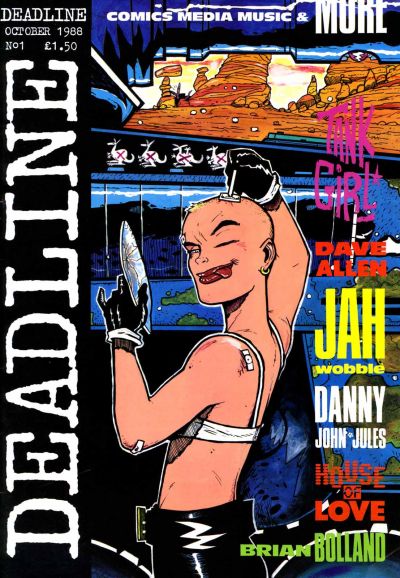Not mentioned in the post: the Christmas-themed Tank Girl window painting we had in 1991.
Hey, I’m bugging you, the folks what still read the blogs, for your comic industry/medium/hobby related questions…put ’em in the comments for this post and I’ll get to them! Well, eventually!
For example, that accursed will richards (as Dr. Doom would call him) says
“Hi Mike, hope the peepers aren’t giving you too much gip.”
Holdin’ together so far!
“I just wondered if you’d had much interest in British Comics (other than 2000ad/Dredd) in the shops you’ve worked in? Thanks”
The 2000AD family of publications and characters do cast a long shadow over the American comic business. If you ask your average comic reader to name a British comic, yeah, chances are they’d say “Dredd.” Possibly Britain’s most mainstreamed comic book character in the U.S. is a British satire/parody of the U.S., which is somehow fitting.
Once the “British invasion” of the 1980s happened in the comics industry, it felt like your general comic reader perhaps got a little more interested in where all these English folk came from, and you started seeing folks trying to track down, say, Alan Moore’s work before he turned up on Swamp Thing. (Not at all pulling from personal experience for this by the way, says the fellow with the full set of Maxwell the Magic Cat.)
There was some increased interest in the UK comics magazine Warrior, for example, the source of Marvelman AKA Miracleman comics that Eclipse started reprinting in the 1980s to huge success. Warrior would feed other U.S. reprint series, like Laser Eraser and Pressbutton, which had a slight following at our shop as well.
Should note now, better late than never, that this isn’t going to be a comprehensive cataloging of every comic with British content that turned up around this time. Just trying to focus on the big ones, and boy howdy Miracleman was one of the biggest ones.
A little bit later at our shop, we stumbled onto a British magazine that a mix of comics and prose articles about music and other pop culture. Several of the strips inside tickled our respective fancies, making us fans of artists like Philip Bond and Jamie Hewlett. In particular, we became big proponents of one of the mag’s stars, the character of Tank Girl:

That’s the first issue from ’88 pictured there…unfortunately, we didn’t get in on the ground floor there. Deadline had been around a year or two before we realized what a goldmine of cartooning it was. I eventually made the drive down to this one store in Los Angeles and made a deal with the folks there for many back issues of the series, going back to that first issue. Just through word of mouth we turned a number of our customers onto the mag (and especially Tank Girl) and we now had quite the demand for this material.
I feel like those are the two Big Ones when it comes to customer interest in British comics. Not to say there weren’t other British comics and graphic novels and such that had a following at our shop (I personally was a huge follower of Eddie Campbell’s Bacchus and related comics) but outside of the 2000AD family, Miracleman and Deadline were the main attractions. I mean, we did try The Beano for a bit, but I don’t think our clientele was ready for anything quite that British!








“If you ask your average comic reader to name a British comic, yeah, chances are they’d say ‘Dredd’.”
That depends on how one defines “average comic reader.” Limit oneself to the people who frequent comics shops, and yes, the answer probably would be “Dredd.” Include everyone who reads comics of any kind, and I would expect “Andy Capp” to get a plurality. “Fred Bassett” might come in second, though I wonder if that really registers as British to American readers.
Trivia for today: In the 1980s, there was a stage musical version of “Andy Capp,” starring (of all people) Sir Tom Courtenay. There was also a TV series (not with Courtenay), and I am a bit surprised that it never came to the U.S. Perhaps the Geordie accents were too thick for us?
Okay, here is an even more useless bit of trivia: The star of that TV series was James Bolam, whom I suppose is best known around these parts for the cop show “New Tricks.” That means that the 1968 film “Otley” is that rarest of things, a film with two Andy Capps (Courtenay played the lead, and Bolam had a supporting role).